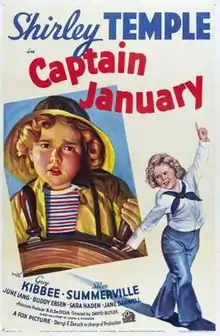Captain January (1936 film)
Captain January is a 1936 American musical comedy-drama film directed by David Butler. The screenplay by Sam Hellman, Gladys Lehman, and Harry Tugend is based on the 1890 children's book of the same name by Laura E. Richards. The film stars Shirley Temple, Guy Kibbee, and Sara Haden.
| Captain January | |
|---|---|
 Theatrical release poster | |
| Directed by | David Butler |
| Produced by | Darryl F. Zanuck |
| Screenplay by | Sam Hellman Gladys Lehman Harry Tugend |
| Based on | Captain January 1890 novel by Laura E. Richards |
| Starring | Shirley Temple Guy Kibbee Slim Summerville Buddy Ebsen Sara Haden June Lang Jane Darwell |
| Music by | Lew Pollack |
| Cinematography | John F. Seitz |
| Edited by | Irene Morra |
| Distributed by | Twentieth Century-Fox Film Corporation |
Release date |
|
Running time | 75 minutes |
| Country | United States |
| Language | English |
| Box office | $1.3 million[1] |
_trailer_1.jpg.webp)
There was a tentative renewal,[2] but the film is in the public domain due to "a legal loophole".[3]
Cast
- Shirley Temple as Helen 'Star' Mason, a 8-year-old girl who is a foundling rescued from the sea by Capt. January
- Guy Kibbee as Captain January, the lighthouse keeper at Cape Tempest, Maine
- Slim Summerville as Captain Nazro, January's friend
- Buddy Ebsen as Paul Roberts, January's friend
- Sara Haden as Agatha Morgan, a stern truant officer
- June Lang as Mary, a 18-year-old woman who is a kindhearted schoolteacher
- Jane Darwell as Mrs. Eliza Croft, a widow smitten with Capt. January
- Jerry Tucker as Cyril Morgan a 10-year-old boy
- George Irving as John Mason, uncle
- Nella Walker as Mrs. Mason, aunt
Production
The movie was the first to use the new sound stage 20th Century Fox dedicated to Will Rogers in 1935. Temple learned her multiplication tables while doing the tap dance sequence down the spiral staircase. There were two notable animal rights abuses on the set during the making of this movie. In the famous Codfish Ball sequence, real lobsters were used on the set as a prop but were deemed potentially hazardous and were cooked and repainted their natural red color. In another scene, a live crane was brought in. The bird kept pecking at Temple's eyes, however and as a way of solving this problem, nails were driven through the webbing of the crane's feet, anchoring it to the ground.[4]
In a scene with Buddy Ebsen near the water, Shirley was originally bare chested. However, complaints from a woman's organization led to the scene being remade with Shirley wearing a top.[4]
See also
References
- Footnotes
- Aubrey Solomon, Twentieth Century-Fox: A Corporate and Financial History Rowman & Littlefield, 2002 p 217
- tentative renewal in 1964
- Hal Erickson, "Captain January Overview", The New York Times
- Temple Black, Shirley (1988). Child Star: An Autobiography. New York: McGraw-Hill Publishing Company. pp. 126–128.
- Works cited
- Edwards, Anne (1988), Shirley Temple: American Princess, New York: William Morrow and Company, Inc.
- Windeler, Robert (1992) [1978], The Films of Shirley Temple, New York: Carol Publishing Group, ISBN 0-8065-0725-X
External links
- Captain January at IMDb
- Captain January at the TCM Movie Database
- Captain January at AllMovie
- Captain January at the American Film Institute Catalog
- Captain January, color
- Captain January, black & white
- A film clip Captain January (1936 film) is available at the Internet Archive